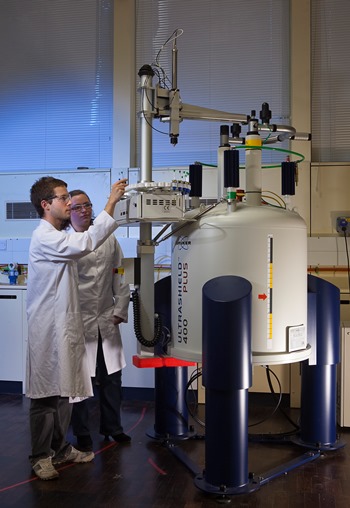Bruker Nanobay 400 MHz
 The Nano400 is a two-channel NMR instrument running ICON NMR 4.2 under TOPSPIN 2.4. It incorporates a 9.39 T Ultrashield Plus Long Hold Time Magnet and is equipped with a 5mm indirect observation z-gradient inverse (1H/13C)- BBI probe and a 60-position BACS sample changer
The Nano400 is a two-channel NMR instrument running ICON NMR 4.2 under TOPSPIN 2.4. It incorporates a 9.39 T Ultrashield Plus Long Hold Time Magnet and is equipped with a 5mm indirect observation z-gradient inverse (1H/13C)- BBI probe and a 60-position BACS sample changer
The Nano400 is an Open Access NMR Instrument, operating 24 hours a day - 7 days a week, with the exception of Mondays between 2-5 PM, which is reserved for instrument servicing and maintenance by the NMR Staff. The Nano400 is available only to research workers from the University of Reading.
Which Experiments Are Available?
By default, seven ICON NMR Experiments: 1H (1D-), 13C (1D-), DEPT-135 (1D-), Edited-HSQC (2D-), HMBC (2D-), COSY (2D-) and NOESY (2D-) are made available to all new users of the Nano400. However, the Nano400 can also run many other proton-detected experiments such as TOCSY, HSQC-TOCSY and ROESY on request. See the 'NMR Experiments and Technical Data' document available in the column on the left.
When Do I Use the Nanobay 400?
Of the two Open Access NMR instruments, the Nano400 is superior for performing proton-detected experiments, as the probe for this instrument has optimized sensitivity for proton. Therefore, if you have a limited amount of sample (see Sample Requirements for Experiments in ICONNMR for the minimum amount of sample which is required in order for each of the above experiments to succeed), you will get much better results by running your proton-detected 2D-NMR experiments (such as edited-HSQC, HMBC, COSY and NOESY) on the Nano400, in preference to the Bruker DPX 400 MHz. Conversely, 1D-NMR experiments involving direct observation of heteronucleii (such as the 1D-experiments 13C, DEPTQ and DEPT-135) will give better results on the Bruker DPX 400 MHz, if only a small amount of sample is available. Very small amounts of sample, which cannot be run in a reasonable time on either of the Open Access NMR instruments, can be submitted to the Internal NMR Service (either the Bruker AV 500 MHz or the AV700 instrument) for acquisition by the NMR staff.
Health and Safety in the NMR Lab [PDF 302kb]
Training is provided to ensure you can use the instrument safe and effective:
- Safety in the NMR lab (PDF 302 kB)
- Training to use NMR instruments (PDF 259kB)
- NMR Sample Preparation (PDF 275kB)
- Experiments in ICON NMR (PDF 817 kB)
- Interpretation of ICON NMR experiments (PDF 619 kB)
